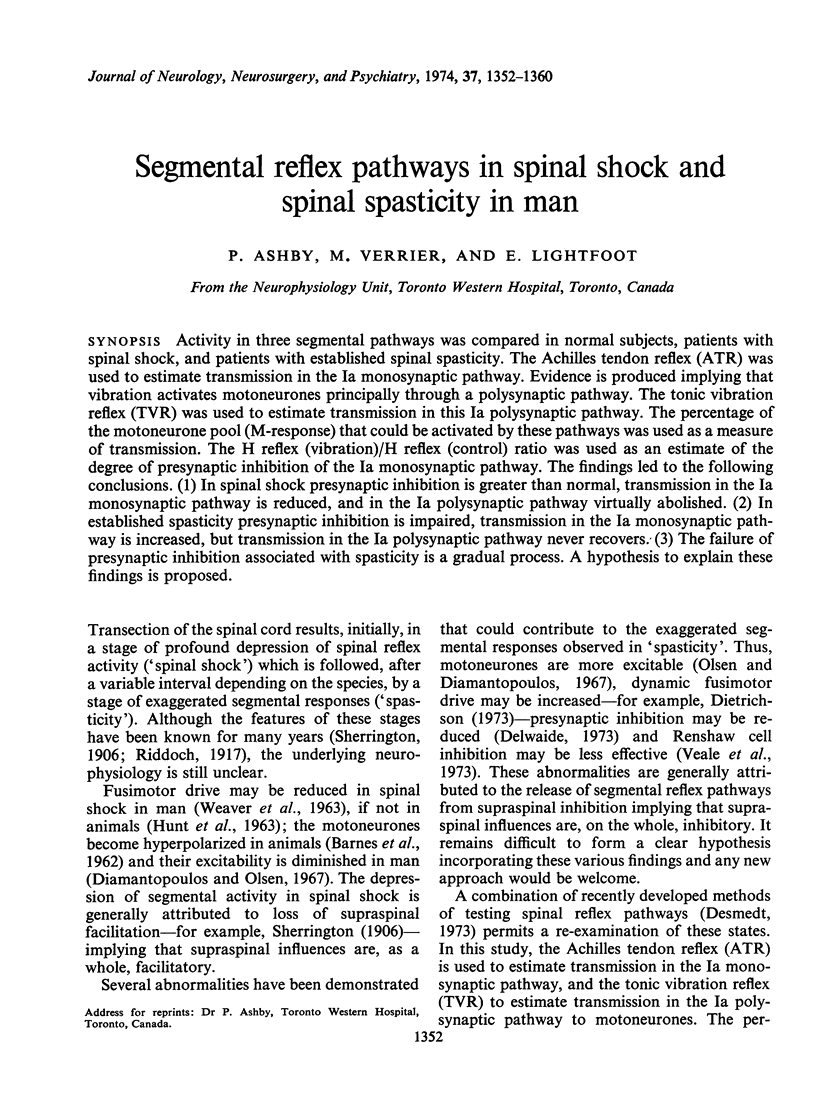Abstract
Activity in three segmental pathways was compared in normal subjects, patients with spinal shock, and patients with established spinal spasticity. The Achilles tendon reflex (ATR) was used to estimate transmission in the Ia monosynaptic pathway. Evidence is produced implying that vibration activates motoneurones principally through a polysynaptic pathway. The tonic vibration reflex (TVR) was used to estimate transmission in this Ia polysynaptic pathway. The percentage of the motoneurone pool (M-response) that could be activated by these pathways was used as a measure of transmission. The H reflex (vibration)/H reflex (control) ratio was used as an estimate of the degree of presynaptic inhibition of the Ia monosynaptic pathway. The findings led to the following conclusions. (1) In spinal shock presynaptic inhibition is greater than normal, transmission in the Ia monosynaptic pathway is reduced, and in the Ia polysynaptic pathway virtually abolished. (2) In established spasticity presynaptic inhibition is impaired, transmission in the Ia monosynaptic pathway is increased, but transmission in the Ia polysynaptic pathway never recovers. (3) The failure of presynaptic inhibition associated with spasticity is a gradual process. A hypothesis to explain these findings is proposed.
Full text
PDF








Selected References
These references are in PubMed. This may not be the complete list of references from this article.
- ANGEL R. W., HOFMANN W. W. THE H REFLEX IN NORMAL, SPASTIC, AND RIGID SUBJECTS. Arch Neurol. 1963 Jun;9:591–596. doi: 10.1001/archneur.1963.00460060021002. [DOI] [PubMed] [Google Scholar]
- Arcangel C. S., Johnston R., Bishop B. The achilles tendon reflex and the H-response during and after tendon vibration. Phys Ther. 1971 Aug;51(8):889–905. doi: 10.1093/ptj/51.8.889. [DOI] [PubMed] [Google Scholar]
- Ashby P., White D. G. "Presynaptic" inhibition in spasticity and the effect of beta(4-chlorophenyl)GABA. J Neurol Sci. 1973 Nov;20(3):329–338. doi: 10.1016/0022-510x(73)90194-9. [DOI] [PubMed] [Google Scholar]
- BARNES C. D., JOYNT R. J., SCHOTTELIUS B. A. Motoneuron resting potentials in spinal shock. Am J Physiol. 1962 Dec;203:1113–1116. doi: 10.1152/ajplegacy.1962.203.6.1113. [DOI] [PubMed] [Google Scholar]
- Barnes C. D., Pompeiano O. Inhibition of monosynaptic extensor reflex attributable to presynaptic depolarization of the group Ia afferent fibers produced by vibration of flexor muscle. Arch Ital Biol. 1970 Apr;108(2):233–258. [PubMed] [Google Scholar]
- Brown M. C., Engberg I., Matthews P. B. The relative sensitivity to vibration of muscle receptors of the cat. J Physiol. 1967 Oct;192(3):773–800. doi: 10.1113/jphysiol.1967.sp008330. [DOI] [PMC free article] [PubMed] [Google Scholar]
- Burke D., Andrews C. J., Lance J. W. Tonic vibration reflex in spasticity, Parkinson's disease, and normal subjects. J Neurol Neurosurg Psychiatry. 1972 Aug;35(4):477–486. doi: 10.1136/jnnp.35.4.477. [DOI] [PMC free article] [PubMed] [Google Scholar]
- Burke D., Andrews C., Ashby P. autogenic effects of static muscle stretch in spastic man. Arch Neurol. 1971 Oct;25(4):367–372. doi: 10.1001/archneur.1971.00490040093011. [DOI] [PubMed] [Google Scholar]
- Burke D., Ashby P. Are spinal "presynaptic" inhibitory mechanisms suppressed in spasticity? J Neurol Sci. 1972 Mar;15(3):321–326. doi: 10.1016/0022-510x(72)90073-1. [DOI] [PubMed] [Google Scholar]
- De Gail P., Lance J. W., Neilson P. D. Differential effects on tonic and phasic reflex mechanisms produced by vibration of muscles in man. J Neurol Neurosurg Psychiatry. 1966 Feb;29(1):1–11. doi: 10.1136/jnnp.29.1.1. [DOI] [PMC free article] [PubMed] [Google Scholar]
- Diamantopoulos E., Zander Olsen P. Excitability of motor neurones in spinal shock in man. J Neurol Neurosurg Psychiatry. 1967 Oct;30(5):427–431. doi: 10.1136/jnnp.30.5.427. [DOI] [PMC free article] [PubMed] [Google Scholar]
- Eklund G. On muscle vibration in man; an amplitude-dependent inhibition, inversely related to muscle length. Acta Physiol Scand. 1971 Nov;83(3):425–426. doi: 10.1111/j.1748-1716.1971.tb05097.x. [DOI] [PubMed] [Google Scholar]
- Gillies J. D., Burke D. J., Lance J. W. Tonic vibration reflex in the cat. J Neurophysiol. 1971 Mar;34(2):252–262. doi: 10.1152/jn.1971.34.2.252. [DOI] [PubMed] [Google Scholar]
- Gillies J. D., Lance J. W., Neilson P. D., Tassinari C. A. Presynaptic inhibition of the monosynaptic reflex by vibration. J Physiol. 1969 Nov;205(2):329–339. doi: 10.1113/jphysiol.1969.sp008968. [DOI] [PMC free article] [PubMed] [Google Scholar]
- HUNT R. S., MELTZER G. E., LANDAU W. M. FUSIMOTOR FUNCTION. I. SPINAL SHOCK OF THE CAT AND THE MONKEY. Arch Neurol. 1963 Aug;9:120–126. doi: 10.1001/archneur.1963.00460080030003. [DOI] [PubMed] [Google Scholar]
- LANDAU W. M., CLARE M. H. The plantar reflex in man, with special reference to some conditions where the extensor response is unexpectedly absent. Brain. 1959 Sep;82:321–355. doi: 10.1093/brain/82.3.321. [DOI] [PubMed] [Google Scholar]
- MERTON P. A. Interaction between muscle fibres in a twitch. J Physiol. 1954 May 28;124(2):311–324. doi: 10.1113/jphysiol.1954.sp005110. [DOI] [PMC free article] [PubMed] [Google Scholar]
- Matthews P. B. The reflex excitation of the soleus muscle of the decerebrate cat caused by vibbration applied to its tendon. J Physiol. 1966 May;184(2):450–472. doi: 10.1113/jphysiol.1966.sp007926. [DOI] [PMC free article] [PubMed] [Google Scholar]
- McCOUCH G. P., AUSTIN G. M., LIU C. N., LIU C. Y. Sprouting as a cause of spasticity. J Neurophysiol. 1958 May;21(3):205–216. doi: 10.1152/jn.1958.21.3.205. [DOI] [PubMed] [Google Scholar]
- Olsen P. Z., Diamantopoulos E. Excitability of spinal motor neurones in normal subjects and patients with spasticity, Parkinsonian rigidity, and cerebellar hypotonia. J Neurol Neurosurg Psychiatry. 1967 Aug;30(4):325–331. doi: 10.1136/jnnp.30.4.325. [DOI] [PMC free article] [PubMed] [Google Scholar]
- SATO M. Response of Pacinian corpuscles to sinusoidal vibration. J Physiol. 1961 Dec;159:391–409. doi: 10.1113/jphysiol.1961.sp006817. [DOI] [PMC free article] [PubMed] [Google Scholar]
- Tsukahara N., Ohye C. Polysynaptic activation of extensor motorneurones from group Ia fibres in the cat spinal cord. Experientia. 1964 Nov 15;20(11):628–629. doi: 10.1007/BF02144828. [DOI] [PubMed] [Google Scholar]
- WEAVER R. A., LANDAU W. M., HIGGINS J. F. FUSIMOTOR FUNCTION. II. EVIDENCE OF FUSIMOTOR DEPRESSION IN HUMAN SPINAL SHOCK. Arch Neurol. 1963 Aug;9:127–132. doi: 10.1001/archneur.1963.00460080037004. [DOI] [PubMed] [Google Scholar]


